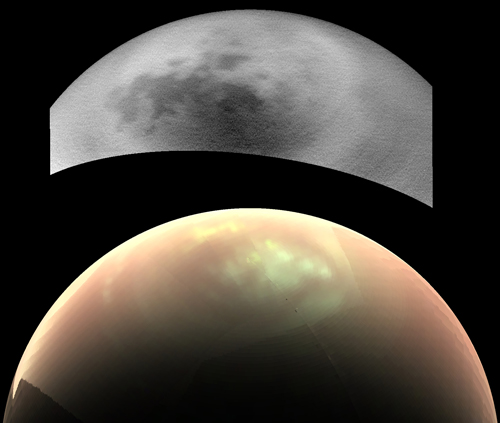This time of year, many children around the world plaster their faces to windows, waiting for the telltale jingle of Santa’s sleigh. Much like these expectant youngsters, scientists studying Saturn’s moon Titan are also eagerly awaiting a present that they hope will come soon.
Their holiday wish? To spot storm clouds near the moon’s northern pole. Every few days, when the Cassini spacecraft beams down a new image of Titan’s northern hemisphere, the team eagerly checks for the fluffy features.
All models say that the storm clouds should have appeared before now, explained Elizabeth Turtle, a planetary scientist at the Johns Hopkins Applied Physics Laboratory in Baltimore, Md. “It’s become this fun waiting game: When we get images, we look and we say, ‘Are there clouds?’”
Clouds of Confusion
Studying Titan’s clouds helps scientists better understand not only its atmosphere but also Earth’s. Titan is the only other body in the solar system with Earth-like liquid cycling between rain and stable liquid surface features, which makes it like a natural Earth analogue.
Instead of a water cycle, Titan has a methane cycle. The moon’s average temperature hovers around a chilly 94 K (for comparison, the freezing point of water is 273 K). Methane condenses high in Titan’s sky as clouds, rains onto the icy surface as a liquid, erodes the surface ice as it runs into lakes and rivers, and evaporates once again into the atmosphere.

And because Titan spins on a tilted axis, similar to Earth’s, seasons affect the atmosphere in a similar way. During the summer, one pole is always sunlit, and one pole is always dark. Warm temperatures on the more sunlit hemisphere cause convective storm cells to form, just like how summer storms form on Earth.
When Cassini arrived at Saturn in 2004, Titan was in the middle of its “January”—northern winter, southern summer. Unsurprisingly, the Cassini team saw lots of southern summer storms.
Titan’s year lasts almost 30 Earth years. In the past few Earth years, Titan’s seasons have shifted, and we’re just entering its “June,” Turtle said. Ever since this shift began, scientists studying Titan have been waiting for the same summer storms to form in northern latitudes.
But those storms, and their clouds, never appeared in Turtle’s images.
Six months ago, after Cassini’s Imaging Science Subsystem (ISS) camera revealed yet another disappointingly stormless north, Turtle started to think that maybe their models were wrong. But then her colleague Jason Barnes, who works with Cassini’s Visual and Infrared Mapping Spectrometer (VIMS) team, emailed to ask, “What’d you think of all those great clouds?”
Cloudy Day…or Not?

“What clouds?” was Turtle’s first thought. She checked her images again and could clearly see all the surface features like lakes and rivers—none was obscured by clouds. But the VIMS images showed something different: a wide swath of bright, smudgy clouds obscuring the exact same surface features Turtle could see clearly from the ISS data.
With the ISS instrument, which “sees” light wavelengths in the near infrared between 980 nanometers and 1–2 micrometers, “we see one cloud, one little cloud, maybe 10 kilometers across,” Turtle said. With the VIMS instrument, however, scientists can see through the visible spectrum and farther into the infrared to wavelengths that stretch to 5 micrometers. With those data, “it looks like there’s this wide expanse of clouds,” she said.
“We were already taking it personally that the clouds aren’t showing up,” Turtle said lightheartedly. “And then to add insult to injury, now they’re only showing up in some wavelengths, but not at others?”
It seemed that a science mystery was afoot.
Cirrus-ly Weird
Turtle presented this puzzler on 14 December at the American Geophysical Union’s Fall Meeting in San Francisco, Calif. What made this mystery especially odd, she explained, was that if one instrument was going to miss the clouds, it should have been VIMS. This is because the tiny particles of liquid, ice (whether methane or water), and dust that make up clouds scatter short wavelengths of light—that’s why we can see clouds on Earth. So VIMS, which sees in longer wavelengths, should be able to penetrate right to the moon’s surface.
First, Turtle and her team confirmed that the two instruments took pictures of the same location. Next, she wondered whether the clouds could be floating over relatively bright terrain and whether that’s why the ISS instrument missed them. But that wasn’t the case because the ISS images clearly showed the darker lakes and seas in the same places that VIMS saw clouds.
Finally, the researchers considered altitude, and the VIMS team ran models to determine the possible height of the clouds. These models revealed that the clouds hovered 40 kilometers above Titan’s surface, right at the top of its troposphere. These clouds were probably very thin and wispy, like cirrus clouds on Earth.
Turtle hypothesized that Titan’s atmospheric haze, formed by all the methane in its atmosphere, could be thick enough to obscure the cirrus clouds from the ISS’s view. After all, “if there were high clouds on a smoggy day on Earth, you wouldn’t be able to tell,” Turtle said.
Seeing Clearly Now
High-flying cirrus clouds are, for now, the best explanation the Cassini team can come up with, and they’ve tasked some graduate students to start digging through old ISS and VIMS data to see if this kind of discrepancy has ever happened before. Meanwhile, the researchers are still hunting for large storm cells.
Mysteries like this one are important because they fuel discovery, explained VIMS team member Robert Nelson of the Jet Propulsion Laboratory in Pasadena, Calif. “We’ve got two instruments that measure the same thing in different ways, and we see something different,” he said. “That’s exciting because when we resolve the differences between the instruments, we learn something more about the physics of what’s going on” on Titan.
After 125 flybys over 12 years, “the fact that Titan can still surprise us was pretty exciting,” Turtle said.
—JoAnna Wendel (@JoAnnaScience), Staff Writer
